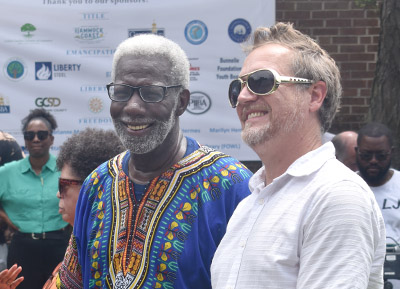Arts
Tubman sculptor sees the power of public art

When “Harriet Tubman: Journey to Freedom” arrived in Georgetown County last week, its sculptor, Wesley Wofford, was inspired and amazed to see people lining the roads to watch and take pictures as it passed by.
“I think it speaks of the importance of her story and her legacy,” Wofford said. “I feel like we live in an age of, who are our role models now? Who are role models for children right now?”
The 9-foot tall, 2,400-pound sculpture made stops in four areas of the county before arriving at Joseph Rainey Park on Front Street in Georgetown, where it was unveiled on Saturday and will remain on display through October.
Although the sculpture is currently touring the United States, Wofford and his wife, Odyssey, don’t attend a lot of the unveilings. However, as frequent visitors to the Waccamaw Neck, they made an exception.
“We want the piece to speak for itself so we don’t really think that we need to be present. We’d rather not potentially pollute any messaging because Wesley is a white artist,” Odyssey said. “If we’re asked, we’re never going to say no because we enjoy coming. It’s not really about the artist. It’s about the art and Harriet and her message. We don’t want us to distract from her message and her importance.”
“Anytime we have attended we always leave talking about, ‘our cup is full.’ For us it’s just been so encouraging to see the unity that brings us together,” Wofford said. “The power of public art [is] its ability to cross language lines and age and gender and race and culture. Everyone can connect to public art in a different way. For us that’s incredibly inspiring.”
Wofford was commissioned to create “Journey to Freedom” in 2017. After a lot of research he decided on an image of a young girl and Tubman – who escaped slavery and helped emancipate hundreds of slaves – struggling past discarded chains on the ground. Wofford hopes it embodies Tubman’s “heroism and importance in American history.”
Once it was done Odyssey posted pictures on social media and it went viral.
“It just resonated with people,” Wofford said.
The couple then started talking about how to make the sculpture accessible, which led Wofford to create the touring piece.
“We feel like it’s a very important time in America as we have important dialogues and conversations about who is represented,” Wofford said.
Because the touring sculpture spends most of its time outdoors, Wofford used a different patina.
“The bronze definitely changes in the different climates and regions that it’s been in,” Odyssey said. “We noticed when it was up north and it was in the snow … it does definitely change the patina.”
Also having an effect are people touching the sculpture and the salt air of the Lowcountry.
Salt “might pull out some greens in her. It might be interesting,” Wofford said. “It will be fun to see. Just as we all do, she’s picking up bits of her travels.”
The Woffords gave the sculpture a bath and a fresh coat of wax at its last stop in Yemassee.
“We were like, we definitely need to give her some TLC,” Odyssey said. “She looks like a new woman.”
The first enslaved child that Tubman rescued was her great-nephew, James Bowley, who lived with her in Philadelphia so he could get a proper education.
“He made such an impact because he was a given the right tools to succeed and lifted up by her,” Wofford said. “That messaging is chillingly important for all of us. What kind of lifting are we doing to make that sort of commitment to the future to make the world a better place?”
Bowley eventually settled in Georgetown and became a teacher, state legislator and newspaper publisher. Tubman sent money to Bowley to pay for educational materials for African-American students in Georgetown County.
“The Georgetown connection is so important and so relevant,” Wofford said. “Her funneling money through Bowley to help education and help lift up during reconstruction. … That’s significant and really important.”
There is a historic marker in front of the house that Bowley lived in at 231 King St. in Georgetown, which is two-tenths of a mile from Joseph Rainey Park.
“Even if she wasn’t physically present here, her presence made an impact. … All of the accomplishments that James Bowley was doing, even just being a teacher,” Odyssey said. “Teachers are the ultimate ripple effect affecting the world. If she never was physically here, she was here in presence and spirit.”
Wofford said the shelf life of a bronze sculpture is about 15,000 years.
“All of us are going to recede to the background and that object is still going to be in the world talking to the next generation of people,” he added.




